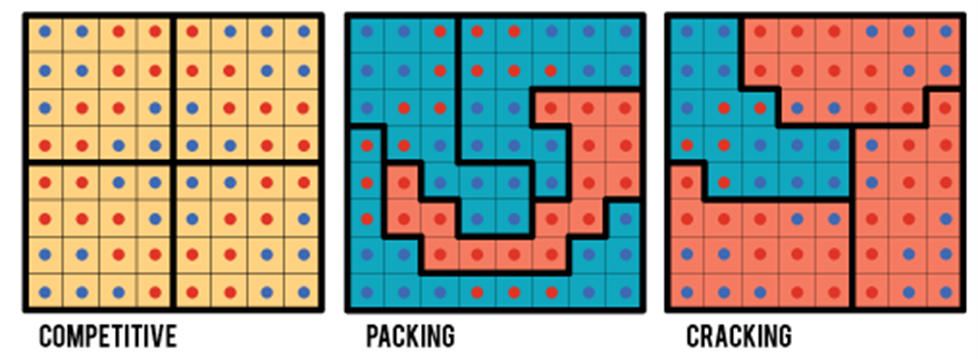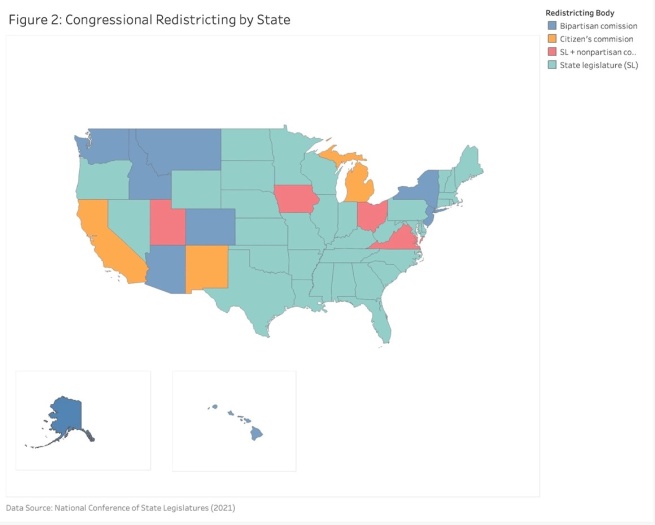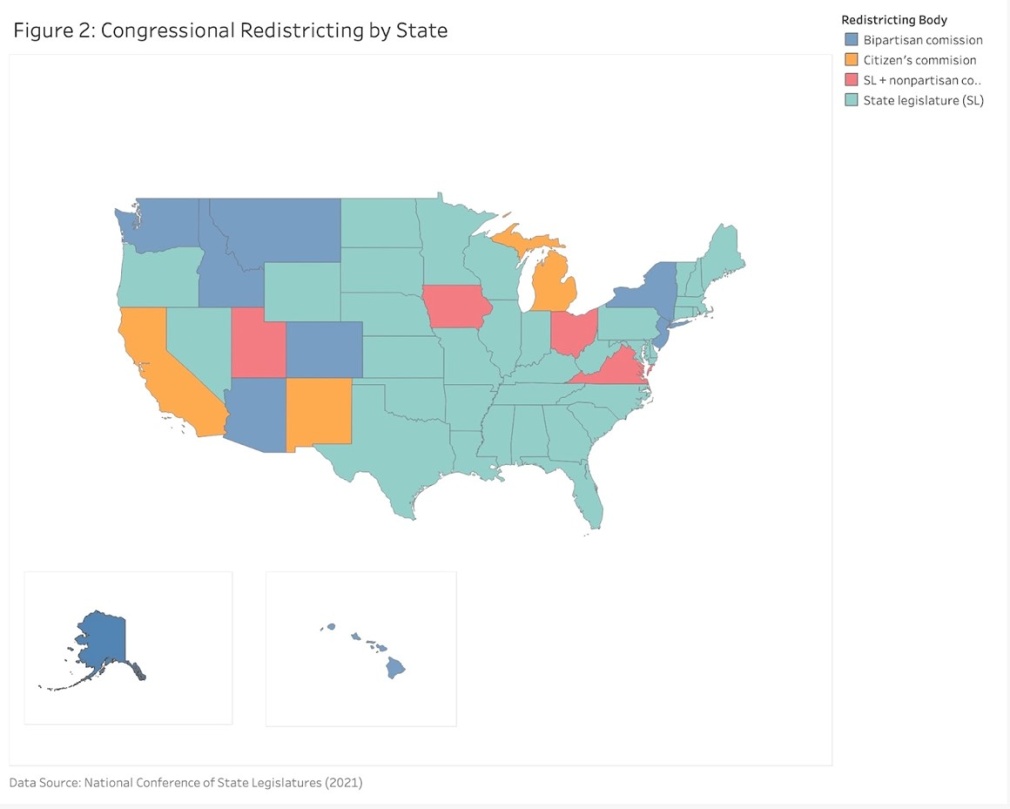
This explainer was last updated January 27, 2023.
Introduction
Redistricting occurs every ten years in accordance with the release of the U.S. Census, and those data are used by redistricting commissions to create districts with balanced population numbers (as required by the Constitution).
Redistricting occurs in tandem with reapportionment, the process of determining the number of representatives each state has in Congress. There are 435 seats in the House of Representatives, and a state may gain or lose seats every decade depending on whether the state’s population has increased or decreased. The guidelines for reapportionment are detailed in the Constitution, but the document says little about how redistricting should be conducted. Instead, Article 1, Section 4 grants power to state legislatures to determine the “time, place, and manner” of congressional elections.
Individual states require that the redistricting process follows certain criteria, which commonly include contiguity (the ability to move between any two points in a district without leaving the district) and compactness (which can be measured in many different ways, for example by minimizing the distance between all the parts of a constituency). These criteria are in place to ensure elections remain competitive and no political party receives an unfair advantage. Redistricting commissions also attempt to preserve communities of interest (COIs), which are regions where residents have common political interests but might not be grouped together by simple administrative boundaries.
Since the Constitution gives state legislatures the authority to oversee redistricting, the group that determines which voters belong in which districts are often the legislators who represent those very districts. Because legislators have a vested interest in expanding their party’s representation, redistricting often has a direct impact on which party has a majority in a state’s government. When legislatures strategically redraw district boundaries to make it easier for one party to win future elections, they are engaging in partisan gerrymandering.
Gerrymandering, Explained
Despite the criteria outlined by state governments to prevent unfair redistricting like contiguity and compactness, the legislators in charge of mapmaking are motivated to draw district lines that cluster voters together to either strengthen or dilute their voting power. The two methods of partisan gerrymandering used most often are “packing” and “cracking.”
“Packing” refers to the drawing of district lines to crowd as many voters of a particular party affiliation or identity group into as few districts as possible. Because their influence is limited to so few districts, they lack the ability to win elections. This was a common strategy in the Jim Crow south to limit the political representation of Black voters. The “cracking” strategy works by drawing district lines in such a way that certain voters are spread out across many districts and thus lack the power to exert political influence. Cracking is commonly seen in urban areas that are densely populated and lean politically liberal. These gerrymandering strategies make it possible for the mapmakers’ party to gain an electoral advantage even if districts contain roughly the same number of voters.

Figure 1: Visual Representation of Packing and Cracking Strategies
Source: Daniel McGlone, Packing and Cracking: Exploring Pennsylvania’s Gerrymandered Congressional Districts (Jan. 23, 2018).
In response to concerns about partisan gerrymandering, several states have passed laws delegating redistricting power to bipartisan commissions or citizens' commissions (Figure 2, below). However, not all independent commissions are equal. Some are completely nonpartisan, while others have an equal proportion of Democrats, Republicans, and independents. In 2021, Congressional Democrats pushed for independent redistricting commissions in all 50 states as part of the For the People Act, but the bill failed to pass.
Recent Legal Controversy
Allegations of partisan gerrymandering are pervasive, and below are brief summaries of relevant Supreme Court cases on redistricting that have occurred within the last several years. This list is by no means exhaustive; rather, it serves as an example of the ways gerrymandering is quantified in court and how states are asked to redress instances of the practice.
Evenwel v. Abbott (2016)
Texas voters Sue Evenwel and Edward Pfenniger alleged that the new district maps based on the 2010 Census violated the Fourteenth Amendment’s Equal Protection Clause. Specifically, they alleged that the new maps failed to follow the “one person, one vote” principle, because they were drawn with the total population in mind, not the registered voter population. This meant that each voting district had approximately the same number of people within it, but had substantially different voting populations.
The Court unanimously sided with Abbot, citing that there was not just one way to fulfill the “one person, one vote” requirement of the Fourteenth Amendment. Therefore, the Texas state legislature’s use of total population instead of voter population was an admissible metric to use in drawing new voting districts. Banning using total population as a metric would exclude non-voters in redistricting plans, argued Justice Ginsburg in the court’s opinion. These individuals are represented by their legislators, even if they did not vote.
Cooper v. Harris (2017)
After the 2010 Census, the North Carolina state legislature redistricted the state to include two more majority-Black districts than the previous map. This was done in order to maintain compliance with Section 2 of the Voting Rights Act, according to the heads of the state-appointed House and Senate redistricting committees. North Carolina voters David Harris and Christine Bowser were registered to vote in these two new districts but alleged that the addition of these two districts weakened the Black vote in other districts (i.e., they were claiming partisan legislators were unfairly “packing” Black voters to gain electoral advantage.)
In a 5-3 decision, the Supreme Court ruled that the North Carolina general assembly relied on race too heavily while drawing their new district maps. In the majority opinion, the court argued that race was the predominant criterion used in creating the new map and that North Carolina had not given substantial reason for why it was given such weight. Justice Alito wrote an opinion partially concurring with the majority opinion in which he argued that the court must assume good intentions on the part of the state legislature and that it was the plaintiff’s duty to show that redistricting was improperly motivated by race. In Alito’s opinion, the plaintiffs had not proven this.
Legal scholars have remarked on a lack of legal standards on gerrymandering in this court case. The Harvard Law Review published this commentary on the proceedings:
“Given the independent harms of partisan gerrymandering and the unique entanglement of race and party, it is both unnecessary and futile for courts to tackle the impossible challenge of distinguishing between racial and partisan gerrymandering. Rather, the fact that Harris could easily have gone the other way suggests the need for an additional standard that addresses partisan gerrymandering directly and thus allows courts to police more accurately the affront to democracy that both racial and partisan gerrymandering represent.”
Gill v. Whitford (2018)
In 2010, Wisconsin residents elected a Republican governor alongside a Republican majority in the Senate and state assembly for the first time in nearly half a century. As a result, Republican legislators drew a district map that plaintiffs alleged would make it nearly impossible for Democrats to win a majority in the state, and thus unconstitutional.
The Supreme Court unanimously sided with the defendant in this case, arguing that the plaintiffs failed to demonstrate Article III standing, which requires proof of an "invasion of a legally protected interest" that is "concrete and particularized." Since there was no individual harm or a significant infringement upon voting rights shown in this case, the Court allowed the state to continue using the map drawn by the legislators.
Rucho v. Common Cause (2019)
In this case, plaintiffs argued that North Carolina’s 2016 congressional district map was a product of partisan gerrymandering. A North Carolina district court ruled in favor of the plaintiffs, a verdict that was appealed by Robert Rucho, head of the state’s Senate redistricting committee.
In a 5-4 decision, the Supreme Court ruled that “partisan gerrymandering claims are not justiciable because they present a political question beyond the reach of the federal courts.” This watershed decision limited the court’s ability to object to partisan gerrymandering on the basis that state legislatures’ power to draw state lines is meant to be checked and balanced by Congress. Put another way, the majority opinion concluded that answering the question, “how much partisan gerrymandering is too much?” is out of the scope of the court’s jurisdiction.
The dissenting opinion, filed by Justice Elena Kagan, remarked that the court’s inability to answer this critical question puts the fundamental rights of equal political participation in jeopardy, and allowing partisan gerrymandering to go unchecked fans the flames of political polarization.
Redistricting Literature
Gerrymandering and redistricting research is exceptionally broad in scope, and there is a vast volume of existing literature that explores how the redistricting process affects the relative power of political parties, minority voters, and other dimensions of political behavior. For example, research conducted by Steve Ansolabehere and Jim Snyder at MIT found that redistricting neither helps nor hurts incumbent legislators, pushing back against what was thought to be a well-established incumbency advantage. Ansolabehere and Snyder have also published with statistician and political scientist Alan Gerber analyzing the influence of redistricting on public finance. The scholars find that counties with more legislative seats per person before a court-ordered redistricting process received more funds from the state after the redistricting process, and counties that lost seats received less funding. Ansolabhere, Gerber, and Snyder also find that the process of redistricting and population equalization diverted approximately 7 billion dollars annually from overrepresented to underrepresented counties.
There is also widespread conversation regarding the effects of redistricting on minority populations, particularly how the creation of majority-minority districts (in which more than half of the population is a racial or ethnic minority) affects that group’s political power in state legislatures. In his piece titled “Race and Redistricting” (2022), David Canon of the University of Wisconsin-Madison details the practice of “racial redistricting:'' the deliberate creation of majority-minority districts to increase their representation in elected office. Canon explores the scholarly debate on this issue, citing arguments of authors who advocate for racial redistricting and those who oppose the practice. Proponents believe that descriptive representation is essential for cultivating trust amongst the electorate (Mansbridge 1999) and achieving descriptive representation, i.e. having elected representatives accurately mirror the demographic makeup of their constituents (Guinier 1995, Phillips 1995, Hawkesworth 2003, Young 2012). In this view, a white Congressman who represents a majority-minority district cannot effectively represent his constituents because he does not have the lived experience of a person of color, and by extension, cannot fully understand the social inequities that non-white communities face.
Those who are opposed to racial redistricting favor a “colorblind” approach to representation because they consider race issues no longer as central as they were in decades past (Thernstrom & Thernstrom 1997, Thernstrom 2009) and that segregating minority voters in the redistricting process only amounts to a “triumph of tokenism” (Guinier 1991). In the Supreme Court case Shaw v. Reno, Justice Sandra Day-O’Connor echoed this view by arguing that racial redistricting “bears an uncomfortable resemblance to political apartheid. It reinforces the perception that members of the same racial group…think alike, share the same political interests, and will prefer the same candidates at the polls.” Ultimately, Canon concludes that the constitutionality of racial redistricting is heavily contested, and it’s likely that its legal permissibility will be determined on a case-by-case basis for the near future.
An increased number of redistricting research efforts are beginning to utilize computational systems to aid in drawing districts that promote minority representation by enabling minority populations to have a realistic shot at electing their candidates of choice. Becker et al. (2021) describe their process for creating race-conscious “effectiveness scores” to achieve this effort and guard against minority vote dilution detailed in the Voting Rights Act.
Among redistricting’s demonstrable financial, social, and electoral consequences at the federal and state levels, there continue to be many challenges quantifying and auditing local redistricting processes. Brian Amos, a professor at Wichita State University, chronicled these difficulties in a piece for MEDSL, and he claims that many of these challenges originate from the lack of accessible data. While some states have their redistricting data available digitally (on a website or by request) in a clean, interactive format, it is more common for this data to be presented in a printable PDF form. These PDFs are sometimes low-quality and difficult to reproduce. Furthermore, Amos has found that some of these local district maps do not meet the constitutional requirement of near-even population numbers (such as Floyd County, Indiana).
Suggested Resources
U.S. Census Redistricting Information and Resources
National Conference of State Legislatures
Professor Justin Levitt’s Guide to Redistricting
Brennan Center Citizen’s Guide to Redistricting
districtR - Tuft’s Metric Geometry and Gerrymandering Group (MGGG)
FiveThirtyEight’s Atlas of Redistricting
U.S. Census Report on Apportionment 2020


